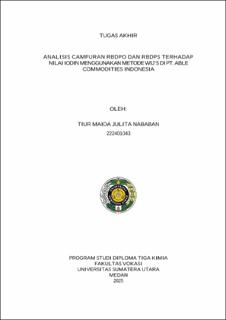| dc.description.abstract | An analysis of the mixture of RBDPO (Refined Bleached Deodorized Palm
Oil) and RBDPS (Refined Bleached Deodorized Palm Stearin) on iodine value has
been conducted using the Wijs method to determine the level of fatty acid
unsaturation. The analysis was carried out at the QA/QC Laboratory of PT. Able
Commodities using iodometric titration with 1% starch indicator. The results
showed that the iodine value of 100% RBDPO was 52.7 and 100% RBDPS was
40.69. The analysis of the composition ratio showed that the highest iodine value
was obtained at a ratio of RBDPO:RBDPS 90:10, which was 51.26, still within the
standard range of RBDPO, and then decreased at ratios of 80:20 (49.63), 70:30
(46.70), 60:40 (45.04), and the lowest at 50:50 (43.46), which approached the
standard of RBDPS. The difference in iodine value at each composition ratio was
caused by the difference in unsaturated and saturated fatty acid content in each
fraction. RBDPO has a higher content of unsaturated fatty acids, so the larger the
proportion of RBDPO in the mixture, the higher the iodine value. Conversely,
RBDPS contains more saturated fatty acids, so an increase in the proportion of
RBDPS in the mixture causes a decrease in iodine value. This is in line with the
PORAM quality standard, where the minimum iodine value for RBDPO is 50-55
and the maximum for RBDPS is 48, indicating that the chemical characteristics of
the two fractions are indeed significantly different. Thus, the variation in the
composition ratio of RBDPO and RBDPS directly affects the level of oil
unsaturation, which is reflected in the iodine value and supported by international
quality standards. | en_US |


